Before arriving in El Calafate, Argentina, with the singular purpose of riding a motorcycle to the southern end of the world with Dainese Expedition Masters, there's the little matter of just getting there.
An abridged glimpse of this commute to the distant gates of Patagonia from O'Hare International (after a redeye flight to Chicago from Hartfield-Jackson) might kick off with a flight to Panama. Fast forward 13 hours, and you could then find yourself in Buenos Aires, sprinting toward customs with 50 pounds of motorcycle gear, a laptop, and a backpack stuffed with enough junk food to survive a year underground. Arriving at the gate drenched in sweat, you might then be told that your plane left without you three minutes ago.
Jabbering in broken Spanish to the poor attendant about flight options, you then speed across town to a regional airport where the last flight to Patagonia for the next two days is departing—while praying for a miracle from the back seat of a cab.
You get the picture. Adventure travel often starts well before the real journey does.
In this case, after 25 hours of slipping between time zones—chasing down luggage and losing count of how little sleep you’ve stolen between takeoff and landing at increasingly remote airports—a river of fire tears across the sky outside your window—and you’re all but certain you’ve either lost touch with reality or the world is finally at its end.
Related: 25 Motorcycle Trips to Tour America's Wide-Open Spaces
You gawk for an embarrassingly long time before realizing you’re staring into the rising sun. It breaks over jagged peaks impossibly far in the distance and shines down on the ground below, revealing grazing cattle in a field drinking from ponds of shimmering gold.
Somehow, you’ve arrived in El Calafate, Argentina—a place as close to the end of the line as any commercial aircraft will take you. And it’s at this moment you remember why you left home in the first place.
You’re here with a singular purpose: To ride a motorcycle with Dainese Expedition Masters to the farthest reaches of a breathtaking, unforgiving landscape, where the winds are as constant as they are violent.
What Is Dainese Expedition Masters?
If you haven’t heard of Dainese Expedition Masters, there’s a good reason for that. It’s part of the Dainese Riding Masters training program, and it’s a pretty exclusive experience to say the least.
Every year, the wizards at Dainese plan three or four motorcycle expeditions (typically groups of about 12 people) to some of the most breathtaking adventure destinations on the planet. They’re open to the public, and if you’ve got the notion (and your money’s green enough), it’s an awfully attractive way for any proper motorcyclist to enjoy a holiday.
Luckily for me, a lowly journalist whose money is sickly pale at best, Dainese invited me out to serve as a prime example of “what not to do” for the visual learners in the group. I paid my way through comic relief, giving the guides and off-road pros something to point and laugh at four or five times a day. If you’re interested in joining one of these all-terrain caravans yourself, here’s what’s in store for you.
It starts out by paying the price of admission, which in the case of this year’s Patagonia excursion, was roughly $8,000 for paying customers. That fee will vary depending on the destination. Expedition Masters is also running a high-altitude tour of the Himalayas this year, as well as an expedition through the rougher parts of the American West via Arizona, Utah, and Nevada.
Each expedition package includes some serious perks. Chief among them is a full suite of Dainese’s latest and greatest adventure gear (these trips also double as real-world testing grounds for safety equipment), which includes everything from a full head-to-toe, four-season touring suit, a carbon-fiber helmet, gloves, boots, and all the odds and ends you could possibly need from base layers to socks. Altogether you’re looking at about $4,000 of premium Italian riding gear delivered to your door (plus luggage to carry it in), so if you’re in need of both a vacation and some new kit, there’s your first justification for booking the trip.
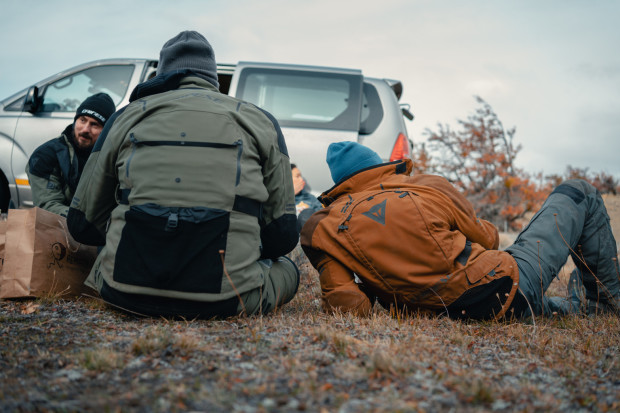
In addition to the high-dollar outfit, your price of entry also covers all your lodging in four-star hotels, all your meals, multiple highly skilled guides and instructors to lead the way, a dedicated support vehicle, and a shiny new motorcycle rental, which is carefully selected by Dainese to match the terrain and style of riding unique to each expedition.
What differentiates Dainese Expedition Masters from your typical guided tour, however, is the skills training that comes along with the package. Dainese’s stated goal with the Expedition Master program is to provide riders with both the gear and essential riding skills they need to safely navigate the world on two wheels. Think of it as a bucket list motorcycle trip, a swanky vacation, and an intermediate riding school all rolled into one.
Sound too good to be true? Here’s what it’s like from the front lines.
Setting Out: El Calafate to Perito Moreno
El Calafate is a picturesque little town nestled beside a glacial lake that’s so blue it looks photoshopped. It's not a bad place to recover from the kind of jetlag that hurts worse than most hangovers.
The tour proper starts early the following morning with a brief presentation covering the day's route and, more importantly, an overview of the motorcycle we’ll be riding for the next week.
Expedition Masters has sourced Yamaha Teneres, BMW GSAs, and Ducati Multistradas in the past, but we’re in for a real treat this week as a fleet of brand-new Ducati Desert X adventure bikes is waiting in the parking lot outside.
A middleweight ADV with 100-plus horsepower and 9 inches of suspension travel is the kind of thing I’d be happy to ride anywhere in the world, but for the fast-paced dirt roads and twisty mountain passes of Patagonia, there’s arguably no better match on the planet.
We break the huddle, head out to the bikes, and waste no time jumping in with both feet. Within five minutes of leaving the hotel, we’re clear of town and tearing down wide gravel backroads, flanked on either side by expansive mountain views and fields teeming with wildlife.
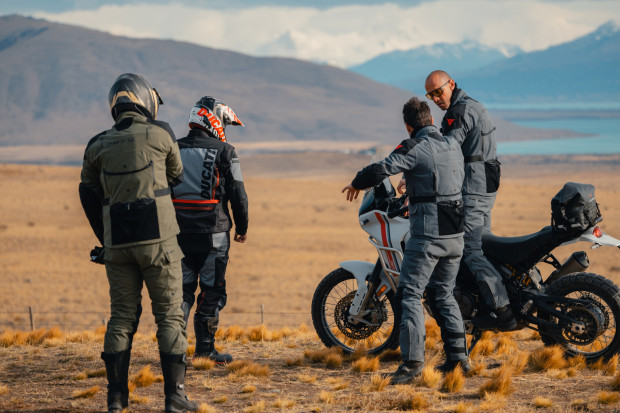
Soon stopping for our first training session of the trip, our guide goes over some off-roading fundamentals like body position and emergency braking in the dirt. Each member of the group takes turns practicing the new skills, while the rest of us sit back and watch foxes chase flightless birds across a nearby field. We’ve truly arrived in an earthly paradise.
For the next 80 miles or so, we fly down dirt roads, kicking up clouds of dust and practicing what we’ve learned. It’s a pattern that will continue throughout the rest of the trip—and throughout all Expedition Masters trips from what I gather: Start the day with a lesson, then immediately put that lesson into practice for the next eight hours.
We break for lunch at a rustic farm doubling as a small restaurant, eat our fill in local produce and slow-cooked lamb, then move on to the crown jewel of the afternoon: Los Glaciares National Park.
People love to say “It’s not the destination, it’s the journey.” That makes for a great Instagram caption or freshman-year tattoo, but in the real world where destinations like the Perito Moreno Glacier exist, why choose sides?
Sitting beside this 19-mile-long slab of slowly creeping ice, hearing it crackle and thunder as 50-ton chunks break away and collapse into the lake below, you start to understand the hype surrounding Patagonia. Everywhere you turn, there’s something new and obnoxiously beautiful waiting to be discovered.
We take the long way home, skirting around the park’s twisty pavement before dropping down into epic views of Lago Argentina. After gassing up for the following day, we head to dinner, eating our body weight in rare steak before resting up for a long day of riding ahead.
Border and Desert Crossing
I spent my adolescence running wild with a general disregard for law and order in all its forms. As a lingering side effect of those formative years, I’ve never quite gotten comfortable around law enforcement.
Even now, a full 10 years since I’ve worn handcuffs against my will, the sight of an official in uniform still trips something in my subconscious. Mentally I’m 18 all over again, sitting at a stoplight with an ounce of weed in the glove box and a squad car in my rearview mirror. It’s in this very state that I encounter my first border crossing of the trip.
I know damn good and well I’ve got nothing to hide, yet standing in front of the stern-faced agent at the Chilean border, I’m mentally preparing for a dimly lit room and the snap of rubber gloves. It’s times like these that a local guide is worth their weight in gold. Lucky for me, Dainese’s hired guns are some of the best in the business.
Our guide, Roberto, steps in with a smile after hearing two sentences of my abysmal Spanish and makes the proper introductions. He hands me all the paperwork I need for the bike, explains our situation to the officer, and sneaks a wink in my direction while the agent stamps a visa into my passport. Crisis averted—and word to the wise: If you’re not one for planning ahead and don’t speak the local tongue, get yourself a tour guide.
From here we move on to the eastern slopes of the Andes Mountains and set about traversing the eighth-largest desert in the world. It’s 80 miles of easy dirt roads followed by hours of pristine two-lane pavement—but just because the roads are good, doesn’t mean the ride is easy. You’ll find two main challenges in this part of the country: slow-moving wildlife and fast-moving winds.
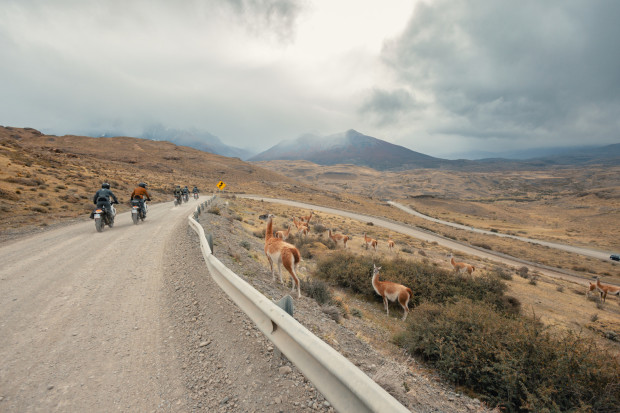
The first is easy enough to avoid. Although the llama-like guanacos of South America blend into the monotone prairies like furry snakes in tall grass, they’re usually in no hurry to cross the road. A watchful eye is all you need to keep their long eyelashes and pouty lips out of your crash bars, but our guide points each one out for good measure.
The wind, on the other hand, is a completely different story. Brutal and constant, the rush of cold air in this region whips at speeds up to 60 mph. That's just 14 knots shy of what meteorologists deem hurricane winds.
The winds blow so hard that our entire convoy of Ducatis is forced to lean into it at a 60-degree angle just to keep the bikes moving straight. Speeds slow to a crawl in these conditions, and I try not to imagine how ridiculous a dozen motorcycles traveling in this gravity-defying configuration must look like to passing traffic.
Challenges come in many forms, and some are sexier than others. Riding in this part of the world is a test of endurance rather than skill. After 80 miles of this nerve-racking game of seesaw, we’re all relieved when the road starts to twist and turn, winding its way through a smooth mountain pass up and out of the brutal wind.
During the final leg of the day’s excursion, we sweep through the most beautiful pavement turns of the trip at speeds no adventure bike should be able to maintain so effortlessly. We pause briefly at the top of the mountain to take in some unobstructed vistas of a river winding across hundreds of miles of open desert before ducking back down the other side of the peak and dropping into Puerto Natales for hot showers and astounding views of the Señoret Channel.
The day ends with a dip in the spa at Remota Patagonia Lodge, dinner at a five-star restaurant, and a hearty serving of fine red wine to keep the aches and pains of the day at bay.
Torres del Paine Dirt Track Tour
Cue the Stones' “Wild Horses” in your helmet as you watch a group of mustangs bask in a sun-drenched field. Feel big, salty tears carve clean streaks across your tired, dusty face before rolling down into your shit-eating grin. Riding through Torres del Paine is communion. An ego death. A true peak experience.
It’s watching your high school sweetheart walk down the aisle in a white dress. It’s hearing Thom Yorke’s voice for the first time with a head full of LSD. It’s getting your first high-paying job fresh out of college after four long years of ramen noodles and Keystone Light, and it’s quitting it 10 years later when you realize your time is worth more than their money.
Standing at the base of these jagged peaks of granite overlooking an electric blue glacial lake, there’s no doubt in my mind: It’s all been worthwhile. The 25-hour flight. The frozen fingers and windburned eyeballs. The customs agents. The border crossings. The cab rides.
And we’re only on day two.
Some places in this world are pure magic, plain and simple. My first ride through Big Sur on an old DR650 was one of them. Watching the sunrise over the rim of the Grand Canyon was another. This one trumps them all.
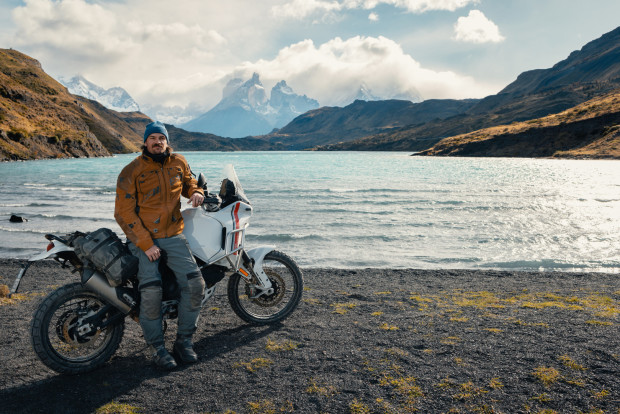
Our day started with an ominous warning from our guide. “I’ve ridden all over the world, and this is the most beautiful road on the planet. You’ll ride nothing after today that compares, so take your time.”
In keeping with that warning, we pull onto a gravel outcropping for the lesson of the day: navigating low-speed turns in loose dirt. No sooner have we broken camp than I find myself putting these skills to use.
Our 150-mile dirt track tour of Torre Del Paine is a mix of fast-moving gravel and treacherous tight corners on shoulderless down-hills. Taking your eyes off the road for more than a few seconds to feast on the jagged peaks and emerald lakes below all but guarantees a near-death experience, but with my new skills in hand, the gamble seems worth taking.
The rest of the day alternates between sightseeing and off-roading, skills practice and photo shoots; we stop for local cuisine with an unobstructed view of Lake Pehoé; and chase a drone back home down a mountain pass.
We make it back to the lodge in time for a few beers at sunset before a dinner of local seafood in the hotel restaurant. The night ends with a review of the route for the following day and a solemn warning: Weather is coming.
Braving the Patagonian Steppe
Between the edge of the Andes and the Atlantic ocean lies a 260,000-mile swath of arid grassland known as the Patagonian Steppe. Those neighboring peaks cast a natural rain shadow over the area, choking its average precipitation down to just two inches a month.
Rain is a rare sight in the area, but as fate would have it, the desert saved its wettest day of the year for our little convoy. I guess it’s only fair that the last section of our journey should include the full Patagonia experience—which is to say riding through every type of weather imaginable before the clock strikes noon.
What starts as a gray drizzle in 40-degree weather quickly deteriorates into a steady rain and near freezing temps as we make our way through the steppe. The wind remains constant, but the dust of the previous days turns to mud. By the time we stop for the day’s lesson, flurries of snow are beginning to fall.
Today’s topic? How to navigate water crossings. What could possibly go wrong?
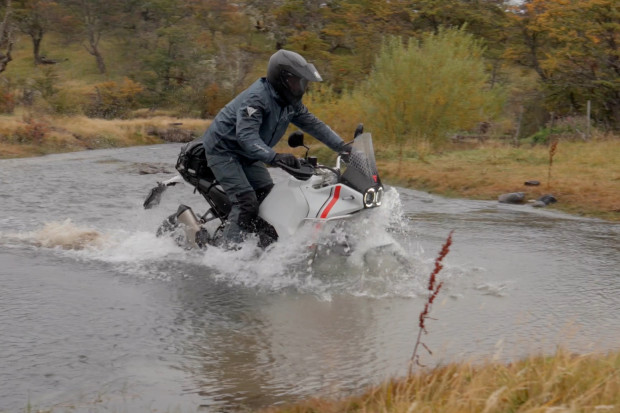
Speaking from experience, I can confidently say that dropping a heavy motorcycle into a creek is an unpleasant endeavor even in the best weather. Factor in howling winds, freezing rain, and a creek that’s colder than your average polar plunge, and you’ve got all the motivation you need to keep both your bike and your body high and dry.
For this lesson, our guide leaves no stone unturned. In fact, we literally wade into the creek to scout the route across and toss out any oversized rocks along the way. Thank you, Gore-Tex.
After going over the fundamentals of throttle and body position from the safety of the shoreline, our guide leads by example, crossing the sketchiest terrain of the trip thus far a half-dozen times from either direction to prove that luck need not factor into the equation.
The bike slides around on the moss-covered rocks, the muddy creek bottom, and the grassy banks of the stream, yet miraculously, our group doesn’t suffer a single mishap throughout the lesson. These are skills worth knowing, and in situations like these, I’m once again reminded that having a skilled guide at the helm is a gift that keeps on giving.
We press on, and as luck would have it, the rain stops, the clouds part, and the sun breaks though to warm our tingling fingers and dry our muddy gear. By the time we cross back into Argentina, the weather is actually nice enough for a roadside picnic, and that’s exactly what we do.
We lounge around, watching the guanaco herds graze, reveling in the final moments of our trip. Even here, lying in the dirt on the side of a remote gravel road, it’s clear there’s no escaping the panoramic postcard views of Patagonia (not that you'd want to). The hype is very real.
Meanest "Road" of the Trip
The last 100 miles of our journey takes place on the most terrifying section of gravel I’ve ever experienced. I use the word “gravel” here loosely, as the rocks comprising this road are more closely related to boulders than pebbles and about as fun to pass through as a like-sized kidney stone.
I grip the bike with my legs, try to take it easy on the bars, and keep reminding myself that you only get better by riding outside your comfort zone. This internal dialogue keeps me sane for the first 10 miles or so, but for the 90 that follow, I resign myself to the mantra that there are much less exciting ways to die and much less noteworthy places to do it in.
Around the 20-mile mark, flying rocks claim their first casualty of the trip, punching a hole in someone’s radiator that can’t be fixed on the side of the road. The bike is loaded into the chase truck for the day, but there’s no cause for concern. We’ve got two spare Ducatis along for the ride this week, and after getting one of them unloaded and shuffling some luggage around, we’re back on the road in short order.
Thirty minutes later, a second radiator meets the same fate, and the mood takes a turn. Now on our last backup of the day, we shoehorn the second downed bike into the back of the truck, and the procession takes on a much more solemn air.
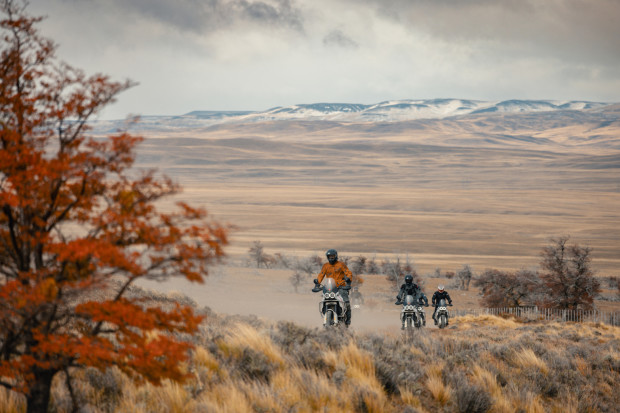
Less than 10 minutes go by before yet another bike catches a rock from another rider’s tire. We all stand around in sheer disbelief as it violently belches coolant into a roadside ditch. Ducati Desert X, we hardly knew thee.
With no “spare” bikes left to ride and no available space to store our third casualty of the day, our guides take turns speaking to each other in rapid Italian while gesturing wildly at the leaking radiator.
Funny how you don’t always need to know the language to know exactly what’s being said: Someone is about to draw the short straw and experience the rest of our journey from the tour guide’s passenger seat.
After some brief deliberation, that honor is bestowed upon the owner of the third damaged bike. He slumps his shoulders in defeat, takes a deep breath, and climbs onto the back of the tour leader’s Ducati for what I can only assume will be the ride of his life. This road is sketchy enough from where I’m sitting, and nothing short of a double Xanax martini could convince me to attempt it from the pillion seat.
Luckily the universe smiles upon us, and for the next hour, we make our way across the gravel wasteland without issue. There are a few sketchy ruts, a few boulders in hiding, and more full-lock tank slappers than I can count, but somehow we all emerge back onto the pavement unscathed, if not a little shaken.
Our final day on the road ends with hot showers, cold drinks, and a very special dinner hosted by a local couple in the dining room of their home with the kitchen on full display. It’s a fitting end to one of the most memorable weeks of my life. Gathered around a large wooden table, our group drains bottles of red wine, swaps stories, and exchanges contact info.
Next up: mental preparation for the 25-hour journey home. As a wise man once said, that’s a small price to pay for a week of living dangerously.
Verdict: Is Dainese Expedition Masters for You?
I’ve spent a lot of time working with adventure touring outfits over the years. Most of them are small businesses run by a handful of enthusiasts, which (while there’s no shortage of enthusiasts on Dainese’s roster) makes for a stark contrast with my experience in a Dainese Expedition Masters trip.
These are two very different types of trips for two very different types of riders, so let me sum up each for those thinking of signing up for Dainese’s upcoming adventures.
First, my experience with Expedition Masters is that it’s extremely riding-focused. You come here to spend time in the saddle, seek out some of the greatest roads in a given region, and build your skills in the process. Expedition Masters is the first adventure tour I’ve seen that incorporates daily on-bike training as part of the itinerary. You’d do well to think of it as a classroom field trip with luxury accommodations that happens to take place in some of the most epic destinations on the planet.
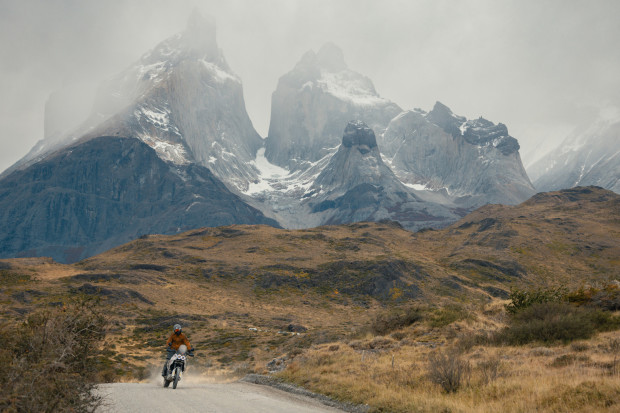
What Expedition Masters isn’t, in my experience, is a cultural immersion in a new and unknown land. You’ll get a taste of local flavor at bars, restaurants, and pit stops along the way, but chopping it up with the locals in small villages, spending hours soaking up the sights, and taking rest days to explore towns and local attractions isn’t part of the itinerary. This is fast-paced and very moto-centric, so if seat time is your top priority, Dainese Expedition masters will be right up your alley.
Speaking of riding, it’s also worth reiterating that for your $8,000, you’re getting roughly $4,000 of new, top-of-the-line riding gear, all of which comes back home with you after the trip is done. It’s also rare for most tour operators to include single-occupancy rooms as part of the standard package, so if you’re the type who likes some privacy at the end of the day, there’s some serious added value there.
You’re also getting a lifetime of memories, and a digital photo album to store them in. All of the images taken for this article were captured by a crew of professional photographers and videographers. You’ll get the very same quality and quantity (we’re talking hundreds of images and roughly two hours of video to use as you see fit) delivered to your inbox shortly after you arrive back home to share with family and friends.
However you look at it, this is a rare chance to combine two of the greatest pleasures in life: the thrill of exploring new places on a motorcycle, and the quiet revelation of taking in the humbling beauty of remote and pristine locations most people will go their entire lives without experiencing. If that’s not bucket list material, I don’t know what is.
from Men's Journal https://ift.tt/P562XDR
via IFTTT
